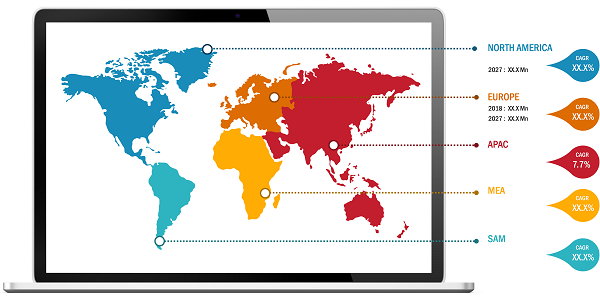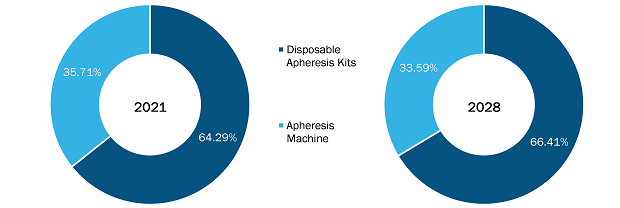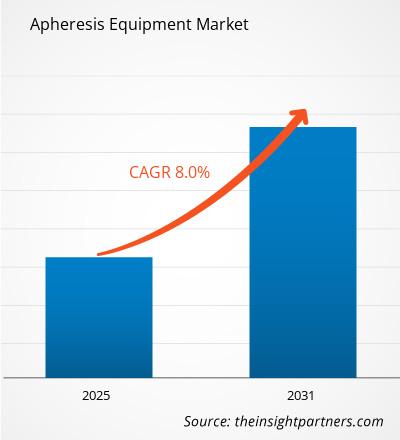Der weltweite Markt für Apheresegeräte wird voraussichtlich von 2.294,11 Millionen US-Dollar im Jahr 2021 wachsen auf 3.854,77 Millionen US-Dollar im Jahr 2031; Es wird geschätzt, dass sie von 2022 bis 2031 mit einer durchschnittlichen jährlichen Wachstumsrate von 8,0 % wachsen wird.
Apherese ist ein Prozess, bei dem Blut vorübergehend aus dem Körper des Spenders entnommen und durch Zentrifugation oder Membrantrennung Prozess, abhängig von den zu trennenden Komponenten. Durch die Apherese werden Verunreinigungen und abnormale Bestandteile im Blut entfernt. Daher wird es zur Heilung oder Bekämpfung von Krankheiten bevorzugt. Der Markt für Apheresegeräte wird auf die steigende Zahl freiwilliger Blutspender, die steigende Inzidenz hämatologischer Erkrankungen und die wachsende geriatrische Bevölkerung zurückgeführt. Allerdings behindern Faktoren wie die hohen Kosten für Apheresegeräte und Komplikationen im Zusammenhang mit Aphereseverfahren das Marktwachstum. Der zunehmende Einsatz der Apheresetechnik in Schwellenländern dürfte jedoch eine lukrative Chance für das Marktwachstum bieten.
Der Markt für Apheresegeräte ist nach Produkt, Technologie, Verfahren, therapeutischem Bereich, Endbenutzer und Geografie segmentiert. Der Bericht bietet Einblicke und eine eingehende Analyse des Marktes für Apheresegeräte und betont dabei verschiedene Parameter wie Markttrends, technologische Fortschritte und Marktdynamik sowie die Analyse der Wettbewerbslandschaft führender Marktteilnehmer.
Strategische Einblicke
Lukrative Regionen des Marktes für Apheresegeräte

Steigende Zahl freiwilliger Blutspender soll den Markt für Apheresegeräte in den kommenden Jahren stärken
Bluttransfusionen helfen, das Leben von Menschen zu retten und zu verbessern. Verschiedene medizinische Fortschritte haben die Behandlung schwerer Krankheiten und Verletzungen verbessert und den Bedarf an Bluttransfusion für Patienten; Überleben und Erhaltung der Patienten; Gesundheit. Das Bewusstsein für die Bedeutung von Bluttransfusionen im Gesundheitswesen ist in der Weltbevölkerung gestiegen, was zu einer steigenden Zahl von Menschen geführt hat, die bereit sind, ihr Blut für medizinische Zwecke zu spenden. Die Weltgesundheitsorganisation (WHO) berichtet, dass im Jahr 2021 weltweit 117,4 Millionen Blutspenden gesammelt wurden. Darüber hinaus werden die Blutspender in der Regel in freiwillige, unbezahlte, bezahlte und Familien-/Ersatzspender eingeteilt. Den Schätzungen der WHO zufolge wurde eine zuverlässige und ausreichende Menge an Blut von freiwilligen/unentgeltlichen Spendern gesammelt.
Der Trend zu Blutspendern ist auch in Ländern mit niedrigem und mittlerem Einkommen deutlich sichtbar. Laut Angaben der Weltgesundheitsorganisation 2021 gab es beispielsweise zwischen 2008 und 2015 in 139 Ländern weltweit einen Anstieg von 11,6 Millionen Blutspenden freiwilliger, unbezahlter Spender. Den Daten der CAG-Jahrestagung im Jahr 2017 zufolge wurden etwa 13.000 Verfahren durchgeführt wurden im Jahr 2016 an 1.087 Patienten durchgeführt. Der höchste Anstieg der Zahl freiwilliger Blutspender wurde in südostasiatischen Ländern und den USA festgestellt, nämlich 83 % bzw. 70 %.
< p>Darüber hinaus sind wahrscheinlich staatliche nationale Bluttransfusionsprogramme, die in den meisten Ländern der Welt entwickelt und eingesetzt werden um die Zahl der Blutplättchen- und Blutspender zu erhöhen. In Indien beispielsweise wurde der National Blood Transfusion Council (NBTC) innerhalb der National AIDS Control Organization (NACO) gegründet; Ebenso wurden innerhalb der State AIDS Control Societies (SACS) State Blood Transfusion Councils (SBTCs) eingerichtet. Daher wird erwartet, dass die steigende Zahl geeigneter Spender auf der ganzen Welt den Bedarf an Apheresegeräten erhöhen wird, die hauptsächlich zur Trennung der Blutbestandteile verwendet werden, die für verschiedene medizinische Zwecke benötigt werden.Produktbasierte Einblicke
Je nach Produkt ist der globale Markt für Apheresegeräte in Einweg-Apherese-Kits und Apheresegeräte unterteilt. Das Segment der Einweg-Apherese-Kits hatte im Jahr 2021 einen größeren Marktanteil und es wird auch erwartet, dass der Markt im Prognosezeitraum aufgrund der zunehmenden Verwendung dieser Kits bei Apherese-Verfahren eine höhere CAGR verzeichnen wird.< /p>
Markt für Apheresegeräte, nach Produkt – 2021 und 2031

Technologiebasierte Einblicke
Aufgrund der Technologie ist der globale Markt für Apheresegeräte in Zentrifugation und Membrantrennung unterteilt. Im Jahr 2021 hatte das Segment der Membrantrennung einen größeren Marktanteil und wird aufgrund der präzisen Trennung der gewünschten Komponenten aus der Vollblutlösung auch in den kommenden Jahren voraussichtlich am schnellsten wachsen.< /p>
Prozedurbasierte Einblicke
Auf der Grundlage des Verfahrens ist der globale Markt für Apheresegeräte in Plasmapherese, Photopherese, Erythrozytapherese, Leukapherese, Thrombozytenpherese, und LDL-Apherese. Im Jahr 2021 hielt das Segment Plasmapherese den größten Marktanteil. Darüber hinaus wird erwartet, dass auch das LDL-Apherese-Segment in den kommenden Jahren am schnellsten wachsen wird.
Therapeutic Area-Based Insights
Basierend auf dem Therapiegebiet ist der globale Markt für Apheresegeräte in Hämatologie, Nierenerkrankungen, Neurologie und andere Therapiegebiete unterteilt. Im Jahr 2021 hielt das Segment Hämatologie den größten Marktanteil und wird voraussichtlich auch in den kommenden Jahren am schnellsten wachsen.
Endbenutzerbasierte Erkenntnisse
Basierend auf dem Endbenutzer ist der weltweite Markt für Apheresegeräte in Blutbanken/Blutspendezentren, Krankenhäuser und Krankenhäuser unterteilt. Kliniken und ambulante chirurgische Zentren. Im Jahr 2021 werden die Krankenhäuser & Das Kliniksegment hielt den größten Marktanteil und wird voraussichtlich auch im Zeitraum 2022 bis 2031 mit der höchsten CAGR wachsen.
Aufgrund der geografischen Lage ist der globale Markt für Apheresegeräte in Nordamerika, Europa, Asien-Pazifik, Naher Osten und Asien unterteilt. Afrika und Südafrika & Zentralamerika. Der globale Markt für Apheresegeräte in Nordamerika hatte im Jahr 2021 den größten Marktanteil. Die USA dominierten den Markt für Apheresegeräte in Nordamerika. Es wird erwartet, dass das Marktwachstum im Land aufgrund einer steigenden Zahl von Aphereseverfahren, zusammen mit Apheresezentren und einem zunehmenden Zugang zu einer gut entwickelten Gesundheitsinfrastruktur mit der höchsten CAGR wachsen wird.
< span style="Schriftfamilie: Verdana, Genf, Sans-Serif; Schriftgröße: 10pt;">Der kanadische Markt für Apheresegeräte wird aufgrund der steigenden Zahl von Plasmaaustauschverfahren und neurologischen Aphereseverfahren im ganzen Land wahrscheinlich wachsen. Auch der Markt für Apheresegeräte in Mexiko dürfte aufgrund der zunehmenden Entwicklung des Gesundheitssystems Wachstumschancen haben.
Der Markt für Apheresegeräte ist geografisch in Nordamerika (USA, Kanada und Mexiko), Europa (Großbritannien, Deutschland, Frankreich, Italien, Spanien und übriges Europa) unterteilt. , Asien-Pazifik (China, Japan, Indien, Südkorea, Australien und übriger Asien-Pazifik), Naher Osten und Asien. Afrika (VAE, Saudi-Arabien, Afrika und übriger Naher Osten und Afrika) sowie Süd- und Afrika. Mittelamerika (Brasilien, Argentinien und der Rest von Süd- und Mittelamerika).
Unternehmensprofile
Die Der Markt für Apheresegeräte besteht hauptsächlich aus Akteuren wie Medica SPA; Terumo Corporation; B. Braun Melsungen AG; Fresenius Medical Care AG & Co. KGaA; Asahi Kasei Corporation; Haemonetics Corporation; HemaCare Corporation; KANEKA MEDIX CORPORATION;, Kawasumi Laboratories, Inc.; und medicap hospital GmbH unter anderem.
- Historische Analyse (2 Jahre), Basisjahr, Prognose (7 Jahre) mit CAGR
- PEST- und SWOT-Analyse
- Marktgröße Wert/Volumen – Global, Regional, Land
- Branche und Wettbewerbsumfeld
- Excel-Datensatz

Report Coverage
Revenue forecast, Company Analysis, Industry landscape, Growth factors, and Trends

Segment Covered
This text is related
to segments covered.

Regional Scope
North America, Europe, Asia Pacific, Middle East & Africa, South & Central America

Country Scope
This text is related
to country scope.
Häufig gestellte Fragen
High price of apheresis instruments and complications related to apheresis are the main issues preventing the market growth.
The growth of the worldwide apheresis instrument market is ascribed to the rising range of voluntary blood donors, increasing incidence of hematological diseases and increasing geriatric population.
The apheresis instrumental separates blood elements by utilizing centrifugation or membrane separation, betting on the elements to be separated.
Apheresis is a method within which blood is temporarily removed from the donor’s body and separated into numerous elements like plasma, platelets, red blood cells further as white blood cells, by centrifugation or membrane separation process. The impurities and unusual elements within the blood are removed by the method of apheresis.
Trends and growth analysis reports related to Life Sciences : READ MORE..
The List of Companies
- Medica SPA
- Terumo Corporation
- B. Braun Melsungen AG
- Fresenius Medical Care AG & Co. KGaA
- Asahi Kasei Corporation
- Haemonetics Corporation,
- HemaCare Corporation
- Kaneka Medix Corporation
- Kawasumi Laboratories, Inc.
- Medicap Clinic GmbH
The Insight Partners performs research in 4 major stages: Data Collection & Secondary Research, Primary Research, Data Analysis and Data Triangulation & Final Review.
- Data Collection and Secondary Research:
As a market research and consulting firm operating from a decade, we have published and advised several client across the globe. First step for any study will start with an assessment of currently available data and insights from existing reports. Further, historical and current market information is collected from Investor Presentations, Annual Reports, SEC Filings, etc., and other information related to company’s performance and market positioning are gathered from Paid Databases (Factiva, Hoovers, and Reuters) and various other publications available in public domain.
Several associations trade associates, technical forums, institutes, societies and organization are accessed to gain technical as well as market related insights through their publications such as research papers, blogs and press releases related to the studies are referred to get cues about the market. Further, white papers, journals, magazines, and other news articles published in last 3 years are scrutinized and analyzed to understand the current market trends.
- Primary Research:
The primarily interview analysis comprise of data obtained from industry participants interview and answers to survey questions gathered by in-house primary team.
For primary research, interviews are conducted with industry experts/CEOs/Marketing Managers/VPs/Subject Matter Experts from both demand and supply side to get a 360-degree view of the market. The primary team conducts several interviews based on the complexity of the markets to understand the various market trends and dynamics which makes research more credible and precise.
A typical research interview fulfils the following functions:
- Provides first-hand information on the market size, market trends, growth trends, competitive landscape, and outlook
- Validates and strengthens in-house secondary research findings
- Develops the analysis team’s expertise and market understanding
Primary research involves email interactions and telephone interviews for each market, category, segment, and sub-segment across geographies. The participants who typically take part in such a process include, but are not limited to:
- Industry participants: VPs, business development managers, market intelligence managers and national sales managers
- Outside experts: Valuation experts, research analysts and key opinion leaders specializing in the electronics and semiconductor industry.
Below is the breakup of our primary respondents by company, designation, and region:

Once we receive the confirmation from primary research sources or primary respondents, we finalize the base year market estimation and forecast the data as per the macroeconomic and microeconomic factors assessed during data collection.
- Data Analysis:
Once data is validated through both secondary as well as primary respondents, we finalize the market estimations by hypothesis formulation and factor analysis at regional and country level.
- Macro-Economic Factor Analysis:
We analyse macroeconomic indicators such the gross domestic product (GDP), increase in the demand for goods and services across industries, technological advancement, regional economic growth, governmental policies, the influence of COVID-19, PEST analysis, and other aspects. This analysis aids in setting benchmarks for various nations/regions and approximating market splits. Additionally, the general trend of the aforementioned components aid in determining the market's development possibilities.
- Country Level Data:
Various factors that are especially aligned to the country are taken into account to determine the market size for a certain area and country, including the presence of vendors, such as headquarters and offices, the country's GDP, demand patterns, and industry growth. To comprehend the market dynamics for the nation, a number of growth variables, inhibitors, application areas, and current market trends are researched. The aforementioned elements aid in determining the country's overall market's growth potential.
- Company Profile:
The “Table of Contents” is formulated by listing and analyzing more than 25 - 30 companies operating in the market ecosystem across geographies. However, we profile only 10 companies as a standard practice in our syndicate reports. These 10 companies comprise leading, emerging, and regional players. Nonetheless, our analysis is not restricted to the 10 listed companies, we also analyze other companies present in the market to develop a holistic view and understand the prevailing trends. The “Company Profiles” section in the report covers key facts, business description, products & services, financial information, SWOT analysis, and key developments. The financial information presented is extracted from the annual reports and official documents of the publicly listed companies. Upon collecting the information for the sections of respective companies, we verify them via various primary sources and then compile the data in respective company profiles. The company level information helps us in deriving the base number as well as in forecasting the market size.
- Developing Base Number:
Aggregation of sales statistics (2020-2022) and macro-economic factor, and other secondary and primary research insights are utilized to arrive at base number and related market shares for 2022. The data gaps are identified in this step and relevant market data is analyzed, collected from paid primary interviews or databases. On finalizing the base year market size, forecasts are developed on the basis of macro-economic, industry and market growth factors and company level analysis.
- Data Triangulation and Final Review:
The market findings and base year market size calculations are validated from supply as well as demand side. Demand side validations are based on macro-economic factor analysis and benchmarks for respective regions and countries. In case of supply side validations, revenues of major companies are estimated (in case not available) based on industry benchmark, approximate number of employees, product portfolio, and primary interviews revenues are gathered. Further revenue from target product/service segment is assessed to avoid overshooting of market statistics. In case of heavy deviations between supply and demand side values, all thes steps are repeated to achieve synchronization.
We follow an iterative model, wherein we share our research findings with Subject Matter Experts (SME’s) and Key Opinion Leaders (KOLs) until consensus view of the market is not formulated – this model negates any drastic deviation in the opinions of experts. Only validated and universally acceptable research findings are quoted in our reports.
We have important check points that we use to validate our research findings – which we call – data triangulation, where we validate the information, we generate from secondary sources with primary interviews and then we re-validate with our internal data bases and Subject matter experts. This comprehensive model enables us to deliver high quality, reliable data in shortest possible time.



 Get Free Sample For
Get Free Sample For